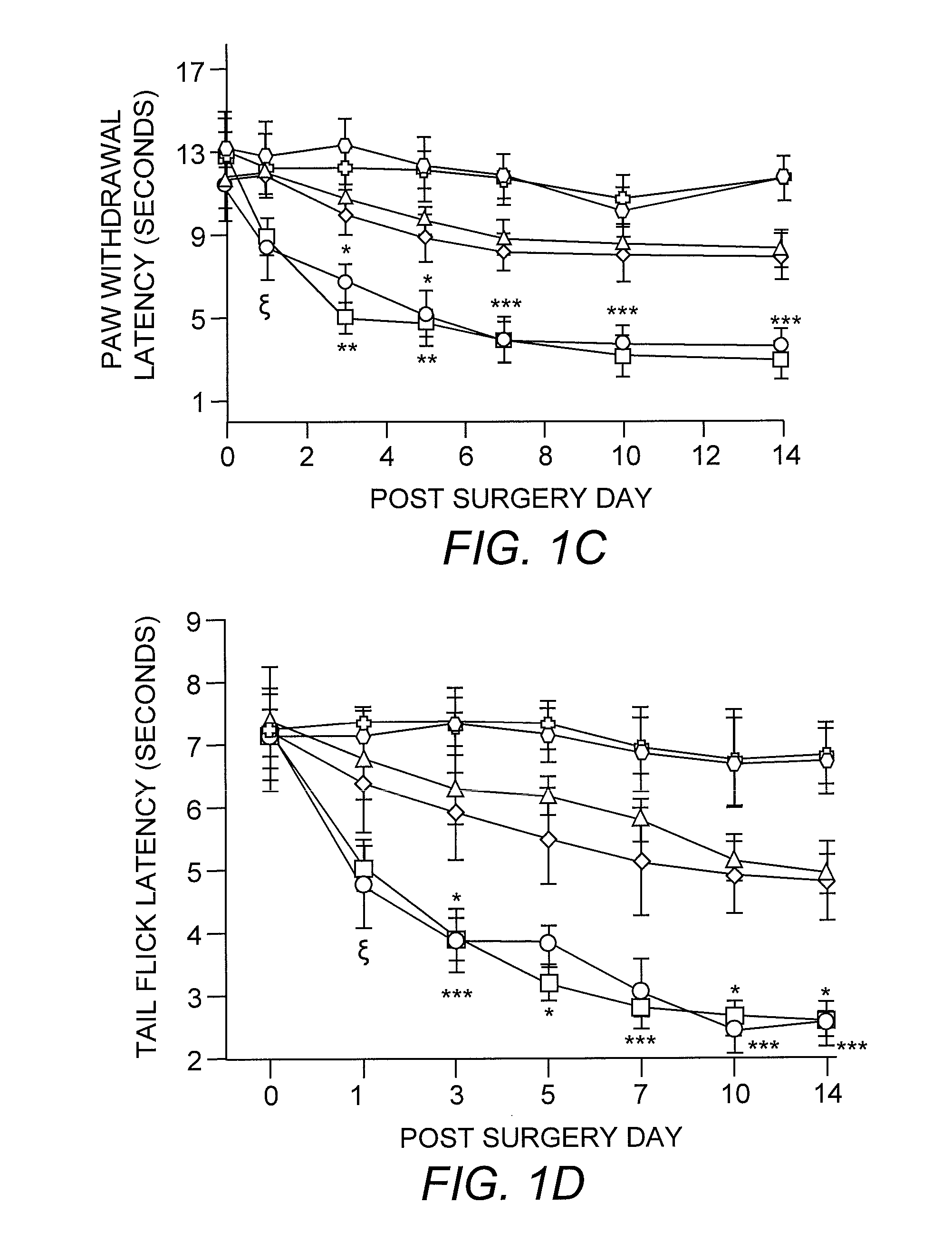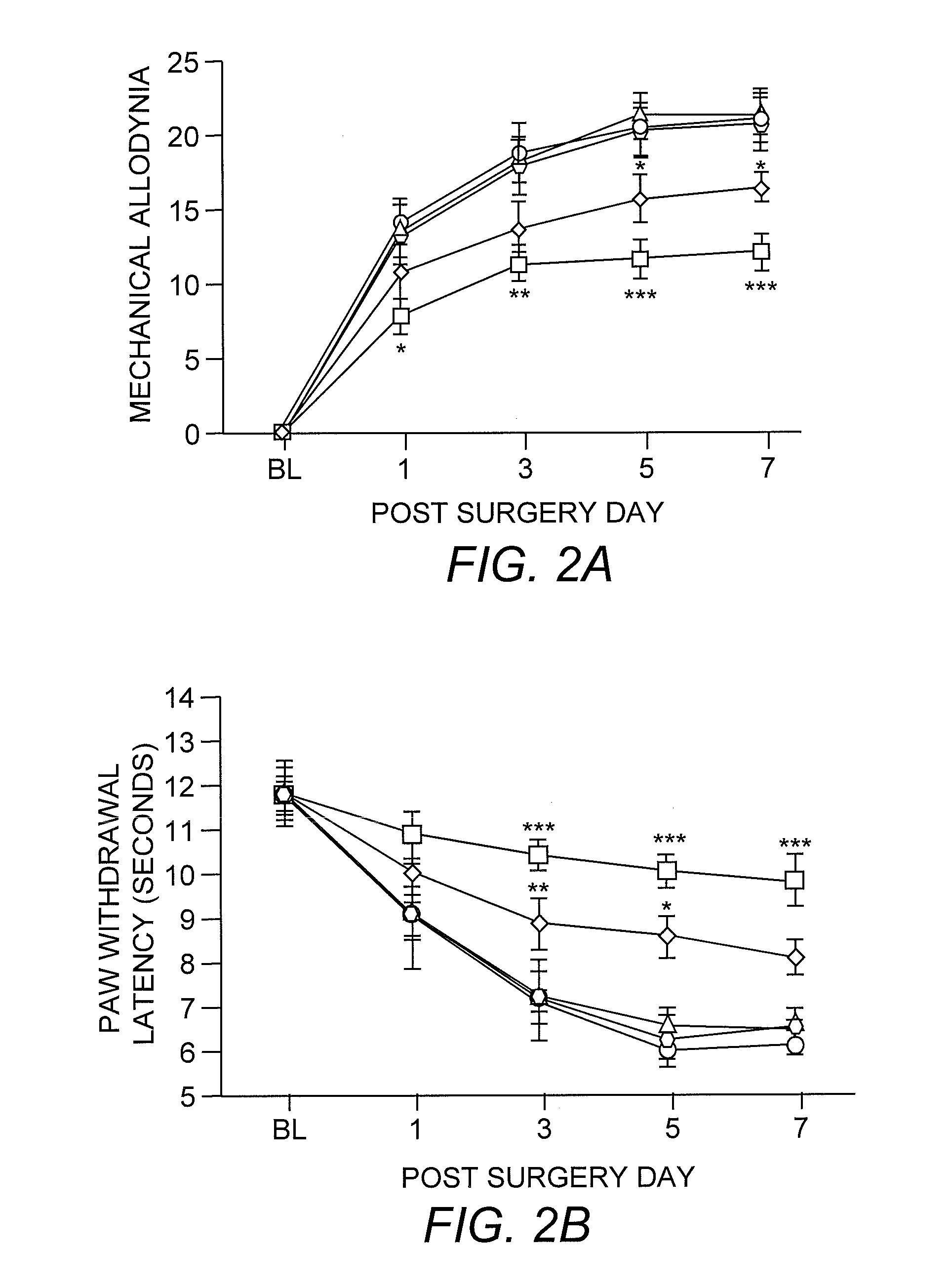Method for preventing or treating neuropathic pain
a neuropathic pain and neuropathic pain technology, applied in the direction of phosphorous compound active ingredients, peptides, dna/rna fragmentation, etc., can solve the problem of unclear genesis of behavioral hypersensitivity, mechanistic links between nerve injury and microglial activation, and the prevalence of neuropathic pain, so as to prevent or treat neuropathic pain and reduce the expression or activity of tlr4.
- Summary
- Abstract
- Description
- Claims
- Application Information
AI Technical Summary
Benefits of technology
Problems solved by technology
Method used
Image
Examples
example 1
ANIMALS
[0028] Mice. C57BL / 10ScNJ mice (TLR4-deleted; n=21) have a homozygous deletion of 74 kb at the tlr4 locus that removes all three TLR4 exons (Poltorak, et al. (1998) supra). C3H / HeJ mice (TLR4-deficient; n=8) possess a dominant-negative point mutation Pro->His at position 712 in the third exon of the TLR4 gene (Poltorak, et al. (1998) supra). C57BL / 10ScSnJ (n=15) and C3H / HeN (n=7) mice are the respective wild-type controls. The C57BL / 10ScNJ, C57BL / 10ScSnJ, and C3H / HeJ strains were purchased from The Jackson Laboratory, and the C3H / HeN strain was purchased from Charles River Laboratories. All mice weighed 25-30 grams at the time of surgery.
[0029] Rats. Male Sprague-Dawley rats (n=48) purchased from Harlan (Indianapolis, Ind.) were used. All weighed 200-250 grams at the time of surgery.
[0030] In accordance with the guidelines set forth by the International Association for the Study of Pain, efforts were made throughout to minimize animal discomfort and to use the fewest anima...
example 2
[0031] Animals were anesthetized with halothane in an O2 carrier (induction, 4% and maintenance, 2%). A small incision to the skin overlaying L5-S1 was made, followed by retraction of the paravertebral musculature from the vertebral transverse processes. The L6 transverse process was partially removed, exposing the L4 and L5 spinal nerves. The L5 spinal nerve was identified, lifted slightly, and transected. The wound was irrigated with saline and closed in two layers with 3-0 polyester suture (fascial plane) and surgical skin staples.
example 3
[0032] For mice, mechanical sensitivity was assessed by applying 0.008- and 0.015-g von Frey filaments (Stoelting, Wood Dale, Ill.) on the plantar surface of the ipsilateral hind paw. For rats, 2- and 12-g von Frey filaments were used. These stimuli are normally nonnoxious. Allodynia was characterized as the number of paw withdrawals in three sets of 10 stimulations each, and was tested on days 1, 3, 5, 7, 10, and 14 after surgery for mice and on days 1, 3, 5, and 7 for rats. Thermal sensitivity was determined by using paw-withdrawal latencies to radiant heat and tail-flick latencies to tail immersion in hot water (49° C.). Three tail-flick and paw-withdrawal latencies were obtained per animal for each testing session. Animals were tested for baseline responses three times before undergoing the L5 spinal nerve transection surgery.
PUM
 Login to View More
Login to View More Abstract
Description
Claims
Application Information
 Login to View More
Login to View More - R&D
- Intellectual Property
- Life Sciences
- Materials
- Tech Scout
- Unparalleled Data Quality
- Higher Quality Content
- 60% Fewer Hallucinations
Browse by: Latest US Patents, China's latest patents, Technical Efficacy Thesaurus, Application Domain, Technology Topic, Popular Technical Reports.
© 2025 PatSnap. All rights reserved.Legal|Privacy policy|Modern Slavery Act Transparency Statement|Sitemap|About US| Contact US: help@patsnap.com



